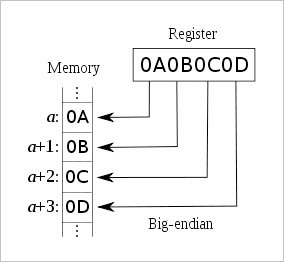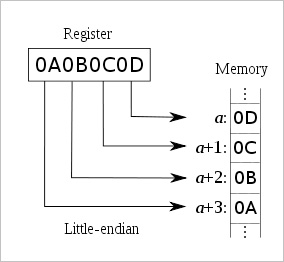3. Data Types and Sizes
|
| |
| 3.1 Numeric Data Types |
| |
| C has a small family of datatypes: Numeric (int, float, double), Character (char), and User defined (struct, union) |
| |
| Numeric Data Types: Depending on the precision and range required, you can use one of the following datatypes. |
| data type |
size
(Win7 64bits) |
signed |
unsigned |
| char |
1 |
char x;
signed char x; |
unsigned char x; |
| short |
2 |
short int x;
short y; |
unsigned short x;
unsigned short int y; |
| default |
4 |
int x; |
unsigned int x; |
| long |
4 |
long x; |
unsigned long x; |
| float |
4 |
float x; |
N/A |
| double |
8 |
double x; |
N/A |
|
| |
 The unsigned version has roughly double the range of its signed counterparts. The unsigned version has roughly double the range of its signed counterparts.
 Signed and unsigned characters differ only when used in arithmetic expressions. Signed and unsigned characters differ only when used in arithmetic expressions.
 The individual sizes are machine/compiler dependent. However, the following is guaranteed: The individual sizes are machine/compiler dependent. However, the following is guaranteed: |
 sizeof(char)<sizeof(short)<=sizeof(int)<=sizeof(long) sizeof(char)<sizeof(short)<=sizeof(int)<=sizeof(long)
 sizeof(char)<sizeof(short)<=sizeof(float)<=sizeof(double) sizeof(char)<sizeof(short)<=sizeof(float)<=sizeof(double) |
| |
| 3.2 Big endian vs. little endian |
| |
 NUXI problem NUXI problem |
– This terminology alludes to the issue that a value represented by the byte-string "UNIX" on a big-
endian system may be stored as "NUXI" on a PDP-11 middle-endian system.
– For numeric data types that span multiple bytes, the order of arrangement of the individual bytes is important. |
 Depending on the device architecture, we have "big endian" and "little endian" formats. Depending on the device architecture, we have "big endian" and "little endian" formats. |
| |
| 3.2.1 Big endian |
| |
 The most significant bits (MSBs) occupy the lower address. The most significant bits (MSBs) occupy the lower address. |
 This representation is used in the power pc processor. This representation is used in the power pc processor. |
 Networks generally use big-endian order, and thus it is called network order. Networks generally use big-endian order, and thus it is called network order. |
 Atomic element size 8-bit, address increment 1-byte (octet) Atomic element size 8-bit, address increment 1-byte (octet) |
 |
 Atomic element size 16-bit, Atomic element size 16-bit, |
 |
| |
 |
| |
| 3.2.2 Little endian |
| |
 The least signficant bits (LSBs) occupy the lower address. The least signficant bits (LSBs) occupy the lower address. |
 This representation is used on all x86 compatible processors. This representation is used on all x86 compatible processors. |
 Atomic element size 8-bit, address increment 1-byte (octet) Atomic element size 8-bit, address increment 1-byte (octet) |
 |
 Atomic element size 16-bit, Atomic element size 16-bit, |
 |
| |
 |
| |